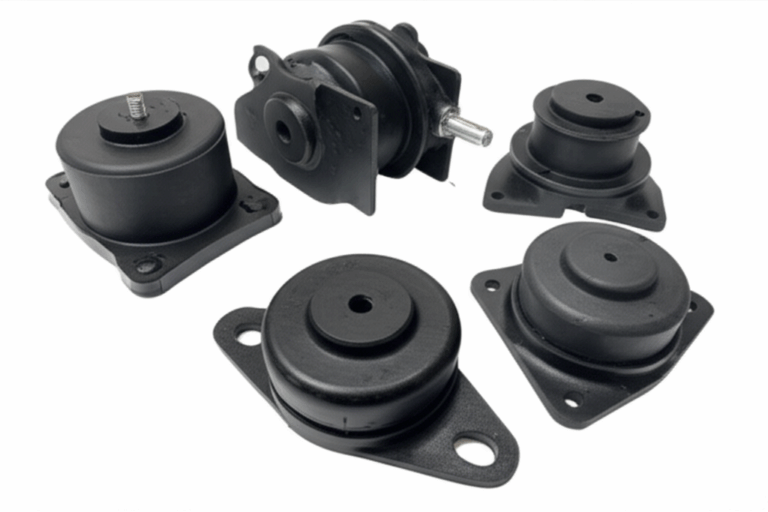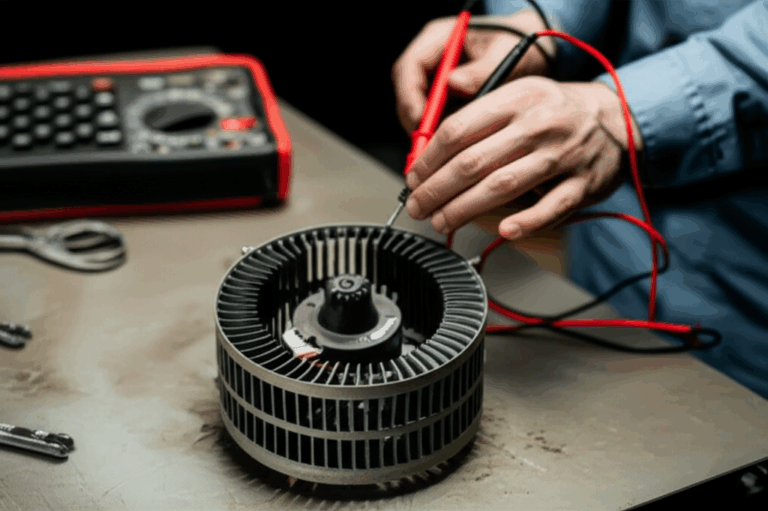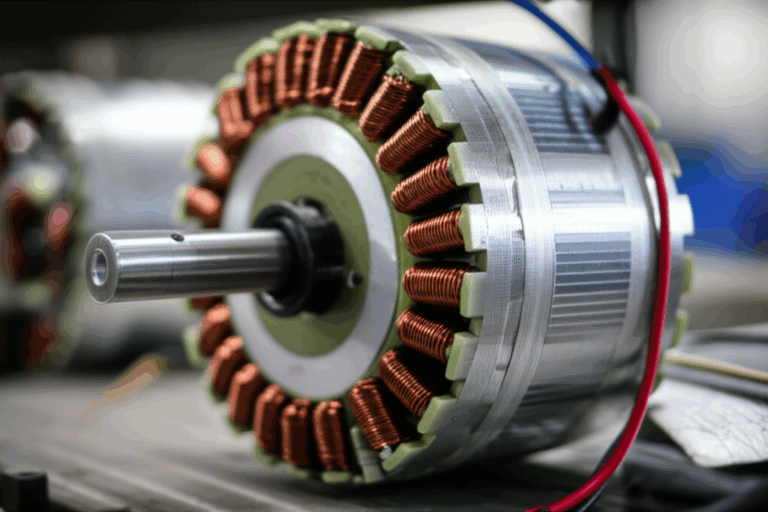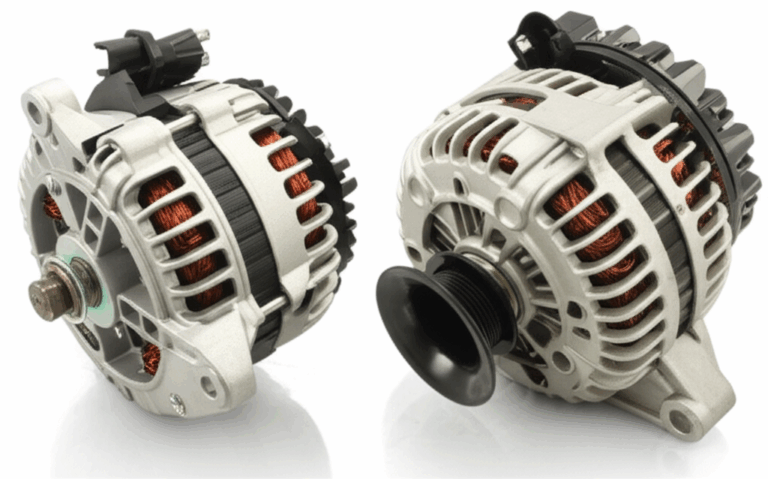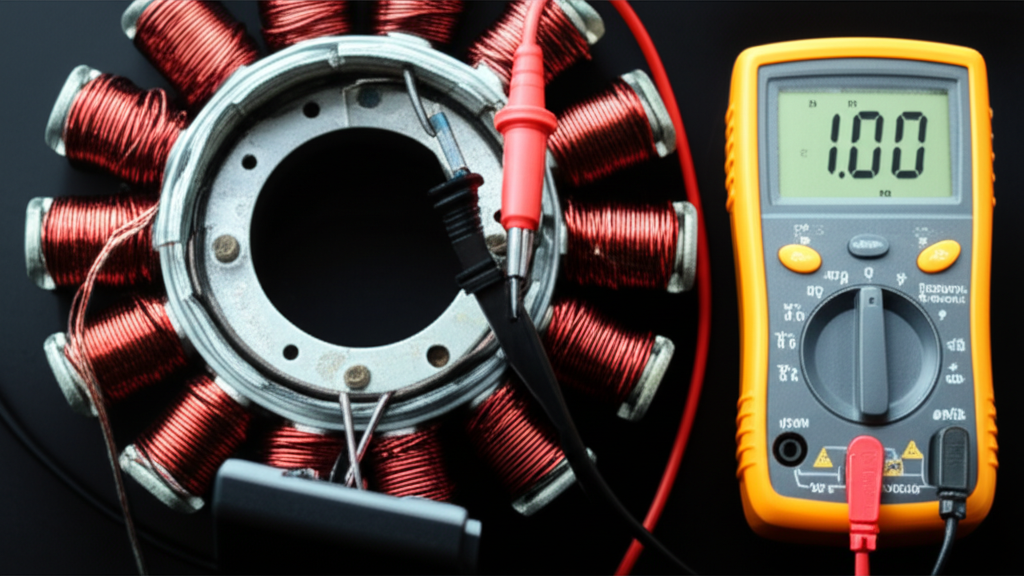
How to Test a 3‑Phase Stator: The Practical, No‑Nonsense Guide Engineers Trust
Every maintenance engineer eventually faces the same question. Is this 3‑phase stator healthy or is it about to take a production line down. If you need a simple, reliable way to check for opens, shorts, and ground faults without guesswork you’re in the right place. This guide walks you through the exact electrical tests, how to interpret the numbers, and what to do next. We’ll also connect the dots to motor core laminations and materials because the way a core is built often explains what you see in the readings.
Your goals are our goals. Higher motor efficiency. Fewer surprises. Safer operation. Better decisions on repair vs replacement. Let’s dig in.
In This Article
- Why Stator Testing Matters for Reliability and Cost
- The Fundamentals You Need Before You Test
- Safety First: Lockout/Tagout and Pre-Checks
- Step-by-Step Electrical Tests for a 3‑Phase Stator
- Interpreting Results Like a Pro
- How Laminations and Materials Affect Test Outcomes
- Which Application Is This For? Matching Tests and Materials to Use Cases
- Data You Can Use: Typical Values and Standards
- Practical Checklist, Tools, and Reporting
- Your Engineering Takeaway and Next Steps
Why Stator Testing Matters for Reliability and Cost
Here’s the problem in plain terms. Stator winding failures sit near the top of motor failure modes. Bearings take a big slice too. Yet electrical issues in windings still account for roughly one third of failures in many studies. A single undetected ground fault or inter‑turn short can punch a hole in your uptime targets. You feel it in energy waste, hot spots, nuisance trips, and emergency repairs.
Testing isn’t just about catching a bad actor today. Trending insulation resistance or winding resistance imbalance over time gives you a heads‑up months in advance. That means you can plan a changeout during a scheduled stop instead of gambling on a midnight callout. Safety also hangs in the balance. No one wants a ground fault energizing a motor frame.
You test a 3‑phase stator to answer four big questions.
- Are any windings open
- Are any windings shorted phase‑to‑phase or inter‑turn
- Is any phase shorted to ground
- Are the three phases electrically balanced
If you can answer those cleanly you can make smart calls on repair, rewind, or replace. You also gain clues about root cause. Moisture. Contamination. Overheating. Loose connections. Each leaves a fingerprint in your readings.
The Fundamentals You Need Before You Test
Let’s ground the discussion. A 3‑phase stator packs three phase windings, often labeled U‑V‑W or T1‑T2‑T3 in the motor terminal box. These windings sit in slots in the stator core. The core itself is a stack of thin electrical steel laminations insulated from each other. That lamination stack reduces eddy currents and cuts core loss. Think of eddy currents like little whirlpools of electrons. Laminations break big whirlpools into tiny ripples that waste less energy.
A few simple concepts help the tests make sense.
- Winding resistance: The DC resistance of each phase. You measure phase‑to‑phase to see if all three are equal. Big imbalance points to issues like loose connections, partial shorts, or wrong lead configuration.
- Insulation resistance: The resistance between a winding and the grounded frame. High is good. Low suggests moisture, contamination, or insulation breakdown.
- Polarization Index (PI) and Dielectric Absorption Ratio (DAR): Ratios that show how insulation absorbs charge over time under a DC test voltage. Clean, dry insulation shows a rising resistance. Contaminated insulation does not.
- Dielectric strength: The insulation’s ability to withstand a high voltage without breakdown. High‑potential (hipot) tests and surge comparison tests probe this.
- Nameplate basics: Understand the rated voltage, insulation class, and connection (delta or wye). These inform test voltage choices and expected resistance ranges.
The core matters more than many people think. Material grade, lamination thickness, and insulation coatings influence iron loss, heating, vibration, and long‑term insulation health. If your motors run hot because of high core loss you see it eventually as brittle insulation and dropping megohm values. Material choices in the electrical steel laminations and their coatings play a quiet but crucial role.
One more simple analogy for permeability. Permeability tells you how easily magnetic flux flows through the core. Picture a sponge soaking up water. A high‑permeability steel soaks up magnetic flux with the same ease. If the sponge hardens with age or contamination it doesn’t soak as well. Your motor responds the same way when magnetic properties degrade from stress or poor material.
Safety First: Lockout/Tagout and Pre‑Checks
Never skip safety. You only need one mistake with a live motor to remember it forever.
- Lockout/Tagout (LOTO): Open the breaker or disconnect. Lock it. Tag it. Use your facility’s procedure without shortcuts.
- Verify de‑energization: Test the line side. Then test the load side at the motor terminals. Test your meter on a known live source before and after. Trust but verify.
- Discharge capacitors: If a VFD or power factor correction sits in the loop discharge the DC bus and any caps per the manufacturer’s guidance.
- Personal Protective Equipment (PPE): Wear arc‑rated gear if your policy requires it. Gloves. Eye protection. Don’t wing it.
- Proper grounding for testing: Bond the motor frame. Use short ground leads. Control your measurement setup to reduce noise and false readings.
Once you’re safe, start with your senses.
- Visual inspection: Look for burn marks, discoloration, cracked insulation varnish, nicked slot liners, damaged motor terminal block, loose or corroded lugs, and contaminated windings.
- Contamination: Oil, coolant, dust, or moisture leave trails. A musty smell or a visible sheen tells on a leaky seal.
- Odor check: The smell of burnt insulation isn’t subtle. Charred varnish points to overheating or overload.
- Mechanical state: Spin the shaft by hand. Gritty bearings or rubbing noises can masquerade as electrical faults in later testing.
Step‑by‑Step Electrical Tests for a 3‑Phase Stator
You don’t need exotic gear to find most faults. A multimeter and a megohmmeter handle 80% of cases. For deeper dives you add an LCR meter, surge tester, or hipot tester. Calibrate your instruments at recommended intervals because a drifting meter wastes your time and can lead you astray.
Test 1: Winding Resistance Test (Multimeter or Ohmmeter)
Purpose: Detect open circuits and phase imbalance.
Procedure:
1) Isolate the motor. Disconnect leads from both power supply and load. Remove jumpers if terminals are configured for delta or wye so you can access each phase separately.
2) Set your meter to low‑ohms range. Four‑wire Kelvin measurement improves accuracy for very low resistance windings.
3) Measure phase‑to‑phase: T1‑T2, T2‑T3, and T3‑T1.
4) Record readings and ambient temperature. Temperature matters because copper resistance rises with heat.
5) Compare values using a resistance unbalance formula. A common approach uses the average of three readings and checks each against the average.
Interpreting results:
- Infinite resistance means an open winding or broken lead.
- Zero or near zero resistance between two terminals means a short. Recheck your setup to confirm you’re not measuring a jumper.
- More than 2–5% deviation between phases suggests imbalance. That can be due to partial shorts, loose connections in the motor terminal box, wrong wire gauge on a lead, or a poor crimp.
Tips:
- For large motors use a dedicated winding resistance bridge for higher precision.
- Temperature correction improves trending. Record ambient and motor temperatures to normalize readings during future tests.
- Don’t forget to test phase‑to‑phase resistance at the motor control center if you suspect cable or MCC terminations. It helps separate motor issues from wiring faults.
Test 2: Insulation Resistance Test (Megohmmeter or “Megger”)
Purpose: Find ground faults and evaluate insulation health.
Procedure:
1) Isolate the motor and discharge any residual energy. Remove line cables from the motor to avoid meggering through connected equipment like a VFD.
2) Connect one megger lead to a winding terminal. Connect the other lead to the grounded motor frame. Test each phase to ground separately.
3) Choose the appropriate test voltage. For motors below 1 kV many techs use 500 V or 1000 V DC. Always check the insulation class and company procedures.
4) Time the test. Record the 30‑second and 1‑minute values for DAR. Record the 10‑minute value for PI if time allows.
5) Repeat phase‑to‑phase insulation tests if you suspect phase‑to‑phase issues within the stator.
Interpreting results:
- Very low resistance below a few megohms on low‑voltage machines points to moisture, contamination, or a direct ground fault.
- For new, dry motors you often see 100–200 MΩ or much higher. Gigaohms are not unusual.
- For in‑service motors, IEEE Std 43 provides guidance on minimum values and the “(kV + 1) MΩ” rule of thumb for machines 1 kV and above. For sub‑1 kV machines many plants flag values under 1–5 MΩ for further action.
- PI = IR at 10 min divided by IR at 1 min. Values above roughly 2–3 indicate clean, dry insulation depending on class. Values near 1 suggest contamination or moisture.
- DAR = IR at 1 min divided by IR at 30 s. Values above about 1.25 are generally acceptable. Higher is better.
Tips:
- Temperature has a strong effect on IR. Insulation resistance falls as temperature rises. If possible apply a temperature correction factor or at least note the temperature for trending.
- If your continuity test shows a direct short to ground don’t apply a megger test until you fix the short. Protect the instrument and the winding.
Test 3: Continuity to Ground (Multimeter)
Purpose: Quick pre‑check for a direct short to ground.
Procedure:
1) Set the multimeter to continuity or low‑ohms.
2) Place one probe on a winding terminal and the other on the grounded frame.
3) Repeat for all three phases.
Interpreting results:
- A beep or very low resistance means a direct ground fault. Stop and investigate before applying higher test voltages.
Test 4: Inter‑Turn Short Detection (Growler or Surge Tester)
Purpose: Spot short circuits between turns within a single coil that a simple DC resistance test often misses.
Options:
- Growler test: For smaller motors you energize the core with the growler and use a thin steel strip or special probe to detect abnormal magnetic attraction that signals a shorted coil. It’s simple and effective in the right context.
- Surge comparison test: You apply high‑frequency, high‑voltage pulses to each phase then compare waveforms. Mismatches point to inter‑turn weaknesses or shorts. This method sees faults under stress that don’t show up in DC resistance checks.
- High potential testing (hipot): You apply a high AC or DC voltage to assess dielectric strength. Follow standards and manufacturer guidance because hipot tests can accelerate insulation aging if misused.
- Partial discharge testing: For medium‑voltage machines partial discharge methods reveal localized insulation breakdowns that precede full failure.
Complementary Diagnostic Checks
Electrical faults rarely live alone. Pair your tests with:
- Vibration analysis: Imbalance or bearing issues can damage windings through mechanical rubs or poor cooling.
- Thermal imaging: A thermal camera can show hot spots at terminal connections, in windings, or in cabling during a controlled run.
- Power quality analysis: Voltage imbalance or harmonics increases heating and shortens insulation life. Check upstream if multiple motors show similar symptoms.
Interpreting Results Like a Pro
Numbers help only if you can turn them into decisions. Let’s walk through common patterns.
- Open circuit symptoms: Infinite phase‑to‑phase resistance on one pair often means a broken lead or a failed coil. You may also hear a motor hum without rotation in some cases when only parts of a winding energize. Visual inspection at the terminal block often finds the culprit in field scenarios like HVAC compressors and pumps.
- Short circuit symptoms: Near zero resistance between phases or sudden breaker trips point to phase‑to‑phase faults. Smell for burnt insulation. Look for copper splatter or carbon tracking.
- Ground fault symptoms: Very low megohm values to ground with a fast collapse in IR readings suggest a direct path to ground. Moistened or contaminated windings are common in washdown or outdoor environments.
- Imbalance findings: A 10–15% resistance imbalance calls for investigation. Loose terminal screws, corroded lugs, or a poor crimp often hide under fiberglass tape or dirt. Correct the connection. Re‑measure. You prevent partial‑short heating and extend life.
- Temperature effects: Expect lower insulation resistance on hot days. When trending IR use the same test voltage at similar temperatures if you can. If not at least note the temperature for each test session.
Case in point. A textile plant trended megger values monthly. One 3‑phase motor showed a steady slide over three months from hundreds of megohms into single digits. The team swapped it during planned downtime and avoided an unplanned trip during peak production. In another common scenario a tech found a 15% winding resistance imbalance on an HVAC compressor. A loose terminal block connection created extra heat. Tightening and re‑terminating restored balance and prevented a winding burnout.
When to repair, rewind, or replace:
- Repair: Loose or corroded connections, nicked leads, or external contamination issues often fall into this camp.
- Rewind: Inter‑turn shorts, insulation breakdown, or phase‑to‑phase faults typically demand a rewind. Evaluate the motor’s criticality and energy efficiency. A rewind may also upgrade insulation systems to fit your duty cycle better.
- Replace: Small, standard motors with severe faults often cost less to replace than to rewind. Factor downtime costs into the decision because availability matters as much as price.
Always document. Capture test values, temperatures, instruments used, and photos of the motor terminal box or nameplate. Today’s notes become next year’s baseline.
How Laminations and Materials Affect Test Outcomes
You came here to test a stator. Still the core’s material and geometry dictate how hot the stator runs and how fast insulation ages. That’s why procurement choices around lamination material and manufacturing process echo in your megger and resistance data.
Material considerations:
- Non‑oriented silicon steels (CRNGO): Workhorse materials for general‑purpose induction motors. Good balance of cost and performance across moderate frequencies.
- Grain‑oriented silicon steels (CRGO): Excellent for transformer cores along the rolling direction. Not typical for rotating machines due to directional properties.
- Higher‑grade silicon steels (M‑grades): Lower core loss at a given flux density. Useful when efficiency targets are tight or duty cycles are severe.
- Cobalt‑iron alloys: High saturation flux density and excellent for high power density machines in aerospace or specialty designs. Premium cost.
- Coatings and insulation varnish: Inter‑laminar coating reduces eddy current paths. Slot liners and varnish impregnation protect copper and improve heat transfer.
Manufacturing and assembly processes also matter:
- Stamping vs laser cutting: Stamping is efficient for high volume with long‑term tool control if dies are well maintained. Laser cutting enables quick prototypes and complex geometries with tight tolerances. Excessive heat input from laser cutting can raise local losses if not optimized so process control is key.
- Annealing and stress relief: Mechanical work hardens the steel and raises loss. Proper annealing recovers magnetic properties. Poor control shows up as higher iron loss and more heating under load.
- Interlocking and bonding: Interlocking features form rigid stacks without welding. Think LEGO bricks that click together. Bonding adhesives reduce vibration and noise without the heat effects of welds because weld heat can degrade magnetic properties if overused.
- Stack factor: The ratio of metal to insulation in the stack. A higher stack factor increases effective cross‑section and torque capability. Coating thickness and lamination flatness affect this ratio.
Why you care during testing:
- High core loss translates into higher steady‑state temperatures. Insulation life roughly halves with every 10 °C above its rating. That’s the old Arrhenius rule of thumb. Hotter stators drift toward lower insulation resistance and earlier ground faults.
- Poorly insulated laminations allow circulating currents. That drives unnecessary heating and can worsen the hum or vibration you chase in vibration analysis.
- Surface contamination sticks more readily to rough, heat‑affected edges from aggressive cutting. That encourages moisture retention and lowers IR over time.
If you’re specifying or sourcing new cores lean on the fundamentals. For a broad view of options and tradeoffs see the overview on motor core laminations. When your design focuses on the stator side in particular review details like tooth geometry, slot insulation systems, and stacking methods in stator core lamination. Don’t forget the rotor either because rotor loss and balance influence stator temperatures and winding stress over time. If you’re comparing designs, a quick pass through rotor core lamination resources can help you balance performance against manufacturability.
Which Application Is This For? Matching Tests and Materials to Use Cases
Different applications push stators in different ways. Tailor your test strategy and material choices to the job.
- HVAC compressor motors: Start‑stop cycles and refrigerant leaks punish insulation. Do quick continuity‑to‑ground checks before a megger if you suspect moisture. Keep an eye on winding resistance imbalance that might signal a loose terminal block under vibration.
- Pumps and fans: Bearings dominate failures so pair electrical tests with vibration analysis. Moisture ingress from seals can lower IR. Trend values. Replace or bake out if needed.
- Generators and alternators: Insulation systems face thermal cycling and sometimes contamination from engine environments. Surge testing finds inter‑turn weaknesses before they escalate. Field winding and armature winding tests may also apply depending on design.
- Industrial induction motors on VFDs: Harmonics raise heating and can stress insulation. Choose materials that handle higher temperature rise and consider partial discharge testing for medium voltage. Power quality analysis upstream is worth your time.
- Electric vehicle motors and BLDC designs: Higher frequencies demand low‑loss materials and thinner laminations. Focus on precise manufacturing, careful slot insulation, and robust impregnation. Advanced surge tests and hipot become more relevant as power density climbs.
- Wind turbine generators and large synchronous machines: Testing procedures still begin with resistance and IR but surge, hipot, and partial discharge testing add confidence. Trending and predictive maintenance pay off because crane time is expensive.
For prototype work or low‑volume motors laser cutting and bonding give you flexibility. For high‑volume runs with simple geometries well‑tuned stamping dies reduce cost per part and yield consistent stack factors. Choose the process that matches your volume and your tolerance for core loss variation. If you’re new to sourcing raw material the primer on electrical steel laminations helps you navigate grade, thickness, and coating selection.
Data You Can Use: Typical Values and Standards
The numbers below aren’t myths. They come from industry practice and recognized standards that engineers use every day. Always check your company standards and the motor manufacturer’s guidance.
| Category / Metric | Description / Typical Values | Source / Relevance |
|---|---|---|
| Winding Resistance Imbalance | Keep phase‑to‑phase resistance within roughly 2–5% | NEMA MG‑1 and IEEE guidance. Imbalance drives heating and efficiency loss |
| Insulation Resistance (IR) New | Dry, new low‑voltage motors often show 100–200 MΩ or higher into the GΩ range | Industry best practice. Low values on new builds signal moisture or defects |
| Insulation Resistance (IR) In‑Service | For machines 1 kV and above a common guideline is (kV + 1) MΩ minimum. For sub‑1 kV many plants flag values under 1–5 MΩ | IEEE Std 43 guidance. Low IR suggests degradation or contamination |
| Polarization Index (PI) | PI = 10‑min / 1‑min IR. About 2.0 or higher indicates healthy insulation for many classes. Higher is better | IEEE Std 43 guidance. Low PI near 1.0 suggests contamination or moisture |
| Dielectric Absorption Ratio (DAR) | DAR = 1‑min / 30‑sec IR. >1.25 good. >1.4 excellent | Industry practice. Quick view of insulation health |
| Common Failure Modes | Stator winding failures roughly 30–40%. Bearings roughly 40–50%. Rotor lower | EPRI and industry studies. Stator testing matters |
| Overheating Impact | Every 10 °C above rating can halve insulation life | Arrhenius rule of thumb. Heat kills insulation fast |
| Downtime Cost | $10k to $500k+ per hour depending on industry | Industry reports. Testing prevents painful surprises |
| PM ROI | Each $1 in PM saves roughly $4–$6 in reactive costs | U.S. DOE guidance. Testing is core PM work |
Practical Checklist, Tools, and Reporting
Don’t overcomplicate the kit. Pack what you need and use it well.
Essential tools:
- Multimeter or ohmmeter for continuity and resistance checks. Choose a meter with a stable low‑ohms range. Brands like Fluke, AEMC, Hioki, or Klein Tools are common in the field.
- Megohmmeter for insulation tests. Pick the right test voltage range for your machines.
- LCR meter for deeper insight into inductance and capacitance if needed.
- Surge tester for inter‑turn diagnostics on critical machines.
- Hipot tester when dielectric strength must be validated under guidance.
- Thermal imaging camera and vibration analyzer for complementary checks.
- Calibrated test leads and Kelvin clips. Bad leads create bad data.
- Labels, camera, and a test report template.
Pre‑test:
- Confirm motor terminal identification. T1, T2, T3 or U, V, W. Verify any internal connections.
- Disconnect motor from the supply and any loads. Remove jumpers for testing each phase separately.
- Verify that the frame ground is solid.
During test:
- Log readings with time and temperature. Include ambient and motor surface temperature where possible.
- Use consistent test voltages across sessions for good trending.
- Apply the resistance unbalance formula and flag anything beyond your policy threshold. Many groups use 2–5%.
Post‑test:
- Document results and upload photos of the terminal box, nameplate, and any damage.
- Trend values over time. PI and DAR trends reveal insulation changes before a single snapshot does.
- If results are marginal dry out the motor in a controlled oven or with space heaters then retest. Moisture plays tricks.
Troubleshooting cues:
- Troubleshooting motor hum: Hum under no load with balanced voltage might come from loose stator wedges or core vibration. Inspect the stator core and wedges during a tear‑down if electrical tests pass yet noise persists.
- Vibration and bearings: Bearing failure can damage windings through rubs or poor cooling airflow. Don’t separate mechanical and electrical worlds in your mind. They dance together.
- Ground fault test stator: When a ground fault appears track the path of moisture or contamination. Solve the root cause not just the symptom.
Maintenance and protection:
- Overcurrent protection and overload relays shield windings. Verify sizing per the nameplate and NEMA MG‑1 guidance.
- Power quality analysis reveals voltage imbalance that drives heating. Correct it at the source. Feed the motor clean power.
- Motor control centers (MCC): Inspect and test at the MCC if several motors show similar issues. Loose bus connections or corroded lugs upstream create downstream trouble.
Your Engineering Takeaway and Next Steps
If you remember only a handful of points let it be these.
- Start simple. Continuity and phase‑to‑phase resistance checks find opens and shorts fast.
- Megger testing gives you the big picture on insulation health. Track PI and DAR for trend insights.
- Respect temperature. It drives both insulation life and test values.
- When results look off check the obvious first. Loose lugs. Wrong jumpers. Contaminated terminal blocks.
- Core materials and manufacturing choices influence heating and lifetime. Better laminations and careful processes pay for themselves in lower losses and longer insulation life.
- Document everything. Today’s numbers become tomorrow’s baseline.
Need a quick material sanity check as you spec a new machine or plan a redesign. Explore how lamination grade, thickness, and coatings influence loss and efficiency in the primer on motor core laminations. If you’re refining stator geometry or stack construction look over current practices and tradeoffs in stator core lamination. For rotor tradeoffs and balance considerations see rotor core lamination. For a broader materials view including grades, thicknesses, and coatings start with electrical steel laminations.
Action plan:
1) Create a standard test sheet for winding resistance, IR, PI, and DAR. Include temperature fields and instrument IDs.
2) Add a simple pass/fail threshold: resistance imbalance < 5%, IR above your chosen minimum, PI above your class target.
3) Establish a quarterly or semi‑annual trending schedule for critical motors. Adjust frequency based on duty cycle and environment.
4) For motors that fail or degrade quickly run a root cause analysis. Check cooling, power quality, and contamination paths. Revisit core material and manufacturing choices if heating runs high.
5) When you engage a motor repair shop ask for before/after test reports and details on the rewinding and impregnation process. Push for transparency because quality shows up in the numbers.
You don’t need to be a motor whisperer to get this right. Follow the steps. Read the results with a cool head. Use the data to drive decisions about your stator design, your maintenance plan, and your procurement strategy. That’s how you keep motors efficient, safe, and off the emergency log.
Notes on terminology used in this guide:
- We covered multimeter test stator checks, DC resistance test methods, continuity test 3‑phase stator techniques, and megger test 3‑phase motor procedures to identify bad stator windings.
- Diagnostic terms like open circuit test, short circuit test motor, inter‑turn short test via surge comparison testing, high potential testing, polarization index test, dielectric absorption ratio, and partial discharge testing appear where they add value.
- Practical topics like test leads connection points, motor terminal identification, understanding motor nameplate, proper grounding for testing, discharging motor windings, and safety precautions for motor testing are included because field success depends on the basics.
- We also touched on mechanical context like rotor damage vs stator damage, bearing failure impact, and vibration analysis because electrical testing lives in a bigger reliability picture.
If you want a second set of eyes on a borderline test report or a lamination material choice reach out to an experienced supplier or engineering partner. A short technical consultation now often saves weeks of rework later.

